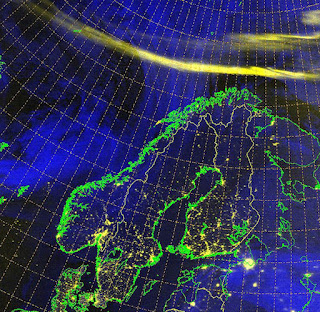Scientists have been monitoring our sun for many years. We even have a branch of the government responsible for watching the weather up there. And why not? The Sun is the largest fusion reactor in our solar system. Anything that happens on the Sun can affect us pretty quickly. For example, a solar flare would only take about 8 minutes for its dangerous x-rays to reach the Earth. That's pretty quick considering how far away the Earth is from the Sun. So what exactly is happening up there that has got so many people concerned? Well its the Sun spots. Or the lack of them lately that has people worried, and the fact that their coming back!
 |
| Sun Spots on Jan. 1, 2011 |
See, the Sun follows roughly an 11 year cycle. The cycle has a beginning and an end - Solar Minimum and Solar Maximum. The start of the current cycle was in 1996. Which is obviously longer than 11 years ago. Like I said, roughly 11 years. These cycles are marked by the number of Sun spots that are observed. The amount of spots go up and down and by charting the amount of spots scientists can determine where we are in the cycle. The problem is that these cycles also correspond with solar flares and CME's (Coronal Mass Ejections) which can have a profound effect on our planet.
Our planet is bombarded with solar particles all the time. Those particles are what cause the Northern and Southern Lights. However when we are hit with really strong solar flares it can cause major electrical damage all over the planet. If you want an easy way to look at it, consider what the Sun throws at us as an electrical charge that has the ability of shutting down all other electrical devices that it comes in contact with. So with that in mind, consider the following scenario.
A Solar Flare hits the Earth. The very first thing to be effected are the satellites that orbit the Earth. What are those satellites controlling? Your cell phones. GPS systems, weather systems, etc.. Almost all manners of communication are handled by satellites. Those would all be wiped out. Now sure, the people who design the satellites have considered this possibility and have built in fail safes. But there are satellites up there that are older and do not have that safeguard. But for the ones that do, it would just mean a temporary shut-down as the satellite protects itself from the solar energy. Unless of course the solar flare was large enough to permanently damage the satellite, which is entirely possible. After the satellites you have the other electrical devices on the planet. Power lines, radar (airlines and their control towers would be in danger here), street lights, building systems, etc... once larger devices on the grid start to go, everything else down the line behind it will follow. It would be like a massive domino effect of electrical failures.
If something like that were to happen, it could cause major chaos everywhere. And something like this has happened before. In 1859 and 1953 major storms hit the Earth. Fortunately for humans at that time there were no major electronics in service then. However today almost everything that we rely on as a society is managed by an electrical device of some sort. Scientists estimate that damage could cost in the trillions of dollars should a major solar event occur today.
And with our solar cycle taking a bit longer than normal to transition to its next maximum some scientists warn that large solar flares are very possible. Predictions have May 2013 as the date for the solar cycle to hit its apex and transition into its next cycle. Sunspot watchers are keeping a close eye on the Sun as they watch for any change in activity that may point to the need for any warning. The National Weather Service also has a portion of their website dedicated to solar weather for those interested in keeping an eye on what is happening up there.
In the picture to the left, a Department Of Defense Satellite snapped this shot showing Aurora light bands stretching across the southern portion of the North Pole. What is significant about this picture is for one, the Aurora lights are longer than normal, and they are as bright as the lights from the country of Scandinavia below. The increased activity does have some worried. But still some are not. They point to this just being a normal occurrence when the sun goes through cycles that last longer than normal. They state that this has happened before as we have been aware of sun activity and tracking it since the 1800's. That may be true, but normal or not, the dependence we have on electrical devices today could be a disaster should they start to fail. If you ask me, we need to keep a close eye on what is happening to our sun and maybe even prepare for some of the negative effects of a major storm. Like I said before, the only thing stopping this from happening is time. It is just a matter of time before these sort of things happen. They are fully beyond our control. We are only able to watch

